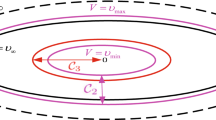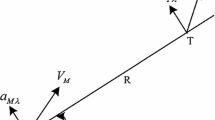Abstract
This paper considers the problem of high-performance global stabilization of an integrator chain via a bounded control at the presence of input disturbance. While nested saturated feedback (NSF) is known as the most inspiring existing solution in the literature, we shall highlight the inherent shortcomings of this approach which cause a poor performance in terms of convergence rate. Then, a novel dual-mode control scheme combining an improved NSF law with a linear matrix inequality (LMI)-based model predictive controller (MPC) is developed to overcome the weaknesses of pure NSF. By offline calculations, a set of nested robust invariant attraction regions and their attributed feedback gains are computed respecting the known bound for disturbance. In online implementation, an improved NSF law is adopted (as the first mode) to bring states within the largest invariant set. The proposed LMI-based state feedback law is applied thereafter (as the second mode) to bring state vector toward the origin with a fast convergence rate. In both modes, the well-known extended state observer (ESO) is employed to effectively suppress the external disturbance. The superiority of the proposed globally stabilizing scheme in terms of faster convergence and improved disturbance rejection ability is demonstrated comparing performances of foremost existing solutions in case of a triple integrator chain.



Similar content being viewed by others
References
Abdessameud, A., Tayebi, A.: Distributed consensus algorithms for a class of high-order multi-agent systems on directed graphs. IEEE Trans. Autom. Control 63(10), 3464–3470 (2018)
Burlion, L., Malisoff, M., Mazenc, F.: Stabilization for a chain of saturating integrators arising in the visual landing of aircraft with sampling. Syst. Control Lett. 135, 104574 (2020)
Madonski, R., Shao, S., Zhang, H., Gao, Z., Yang, J., Li, S.: General error-based active disturbance rejection control for swift industrial implementations. Control Eng. Pract. 84, 218–229 (2019)
Cai, Z., Lou, J., Zhao, J., Wu, K., Liu, N., Wang, Y.X.: Quadrotor trajectory tracking and obstacle avoidance by chaotic grey wolf optimization-based active disturbance rejection control. Mech. Syst. Signal Process. 128, 636–654 (2019)
Ahi, B., Haeri, M.: Novel nested saturated feedback scheme for CLOS guidance via cubature Kalman filter. In: International Conference on Integrated Navigation Systems, pp. 1–6, (2018)
Yang, H., Yu, Y., Zhang, J.: Angle tracking of a pneumatic muscle actuator mechanism under varying load conditions. Control Eng. Pract. 61, 1–10 (2017)
Han, J.: From PID to active disturbance rejection control. IEEE Trans. Ind. Electron. 56(3), 900–906 (2009)
Teel, A.: Global stabilization and restricted tracking for multiple integrators with bounded controls. Syst. Control Lett. 18(3), 165–171 (1992)
Marchand, N.: Further results on global stabilization for multiple integrators with bounded controls. In: IEEE Conference on Decision and Control, pp. 4440–4444, (2003)
Marchand, N., Hably, A.: Global stabilization of multiple integrators with bounded controls. Automatica 41(12), 2147–2152 (2005)
Zhou, B., Duan, G.-R.: Global stabilization of linear systems via bounded controls. Syst. Control Lett. 58(1), 54–61 (2009)
Wang, X., Saberi, A., Stoorvogel, A.A., Grip, H.F.: Control of a chain of integrators subject to actuator saturation and disturbances. Int. J. Robust Nonlinear Control 22(14), 1562–1570 (2012)
Gayaka, S., Lu, L., Yao, B.: Global stabilization of a chain of integrators with input saturation and disturbances: a new approach. Automatica 48(7), 1389–1396 (2012)
Chitour, Y., Harmouche, M., Laghrouche, S.: \(l_p\)-stabilization of integrator chains subject to input saturation using lyapunov-based homogeneous design. SIAM J. Control Optim. 53, 2406–2423 (2015)
Chalanga, A., Plestan, F.: Finite time stabilization of an uncertain chain of integrators by integral sliding mode approach. IFAC-PapersOnLine 50, 9613–9618 (2017)
Tian, B., Lu, H., Zuo, Z., Wang, H.: Fixed-time stabilization of high-order integrator systems with mismatched disturbances. Nonlinear Dyn. 94(4), 2889–2899 (2018)
Amini, S., Ahi, B., Haeri, M.: Control of high order integrator chain systems subjected to disturbance and saturated control: a new adaptive scheme. Automatica 100, 108–113 (2019)
Kothare, M.V., Balakrishnan, V., Morari, M.: Robust constrained model predictive control using linear matrix inequalities. Automatica 32(10), 1361–1379 (1996)
Moradi, S.M., Akbari, A., Mirzaei, M.: An off-line LMI-based robust model predictive control of vehicle active suspension system with parameter uncertainty. Trans. Inst. Meas. Control 41(6), 1699–1711 (2019)
Wang, X., Li, S., Tang, T.: Robust optimal predictive control of heavy haul train under imperfect communication. ISA Trans. 91, 52–65 (2019)
Longge, Z., Xiangjie, L.: The synchronization between two discrete-time chaotic systems using active robust model predictive control. Nonlinear Dyn. 74(4), 905–910 (2013)
Trodden, P.: A one-step approach to computing a polytopic robust positively invariant set. IEEE Trans. Autom. Control 61(12), 4100–4105 (2016)
Teng, L., Wang, Y., Cai, W., Li, H.: Robust fuzzy model predictive control of discrete-time takagi-sugeno systems with nonlinear local models. IEEE Trans. Fuzzy Syst. 26(5), 2915–2925 (2018)
Yu, S., Maier, C., Chen, H., Allgöwer, F.: Tube MPC scheme based on robust control invariant set with application to Lipschitz nonlinear systems. Syst. Control Lett. 62(2), 194–200 (2013)
Yu, S., Zhou, Y., Qu, T., Xu, F., Ma, Y.: Control invariant sets of linear systems with bounded disturbances. Int. J. Control Autom. Syst. 16(2), 622–629 (2018)
Hu, J., Ding, B.: An efficient off-line implementation for output feedback min-max MPC. Int. J. Robust Nonlinear Control 29(2), 492–506 (2019)
Shokrollahi, A., Shamaghdari, S.: Off-line robust model predictive control for lipschitz non-linear systems using polyhedral invariant sets. Asian J. Control 21(6), 1–9 (2019)
Zhou, B., Duan, G.R.: A novel nested non-linear feedback law for global stabilisation of linear systems with bounded controls. Int. J. Control 81(9), 1352–1363 (2008)
Ahi, B., Haeri, M.: Linear active disturbance rejection control from the practical aspects. IEEE/ASME Trans. Mechatron. 23, 2909–2919 (2018)
Yu, S., Böhm, C., Chen, H., Allgöwer, F.: Robust model predictive control with disturbance invariant sets, In: American Control Conference, pp. 6262–6267, (2010)
Gahinet, P., Nemirovskii, A., Laub, A.J., Chilali, M.: The LMI control toolbox. IEEE Conf. Decis. Control 3, 2038–2041 (1994)
Guo, B., Zhao, Z.: Active Disturbance Rejection Control for Nonlinear Systems: An Introduction. Wiley, London (2016)
Funding
This work was funded by the Iran National Science Foundation (INSF) under Grant number 98017237.
Author information
Authors and Affiliations
Corresponding author
Ethics declarations
Conflict of interest
The authors declare that they have no conflict of interest.
Additional information
Publisher's Note
Springer Nature remains neutral with regard to jurisdictional claims in published maps and institutional affiliations.
Appendix A: Proof of Lemma 1
Appendix A: Proof of Lemma 1
The induction method is followed. For \(i=1\), computing derivative of \(z_1={\tilde{x}}_1+\sigma _{0}^{'}(z_{0})\) and applying (13), leads to \({\dot{z}}_1=z_2-\sigma _{1}^{'}(z_{1})\). Also, for \(i=2\) one can show
For \(i=k\) assume \({\dot{z}}_k\) can be calculated as
for \(\forall k\le n-2\). Now, to complete induction procedure, it is required to prove
To that end, taking derivative from \(z_{k+1}\) gives
where incorporating (45) and (47) with some rearrangements results in (46) which completes the induction procedure showing validity of (16). As that last step, taking derivative from \(z_{n}={\tilde{x}}_{n}+\sigma _{n-1}^{'}(z_{n-1})\) gives
Rights and permissions
About this article
Cite this article
Adelipour, S., Ahi, B. & Haeri, M. Dual-mode global stabilization of high-order saturated integrator chains: LMI-based MPC combined with a nested saturated feedback. Nonlinear Dyn 102, 211–222 (2020). https://doi.org/10.1007/s11071-020-05957-0
Received:
Accepted:
Published:
Issue Date:
DOI: https://doi.org/10.1007/s11071-020-05957-0




